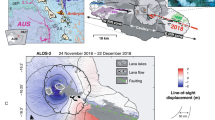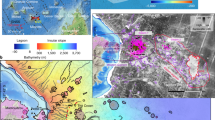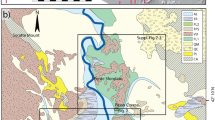Abstract
Subsidence within the main caldera of Askja volcano in the North of Iceland has been in progress since 1983. Here, we present new ground- and satellite-based deformation data, which we interpret together with new and existing micro-gravity data, to help understand which processes may be responsible for the unrest. From 2003 to 2007, we observe a net micro-gravity decrease combined with subsidence and from 2007 to 2009 we observe a net micro-gravity increase while the subsidence continues. We infer subsidence is caused by a combination of a cooling and contracting magma chamber at a divergent plate boundary. Mass movements at active volcanoes can be caused by several processes, including water table/lake level movements, hydrothermal activity and magma movements. We suggest that, here, magma movement and/or a steam cap in the geothermal system of Askja at depth are responsible for the observed micro-gravity variations. In this respect, we rule out the possibility of a shallow intrusion as an explanation for the observed micro-gravity increase but suggest magma may have flowed into the residing shallow magma chamber at Askja despite continued subsidence. In particular, variable compressibility of magma residing in the magma chamber as well as compressibility of the surrounding rock may be the reason why this additional magma did not create any detectable surface deformation.









Similar content being viewed by others
References
Altamimi Z, Collilieux X, Legrand J, Garayt B, Boucher C (2007) ITRF2005: a new release of the International Terrestrial Reference Frame based on time series of station positions and Earth Orientation Parameters. J Geophys Res 112:B09401. doi:10.1029/2007JB004949
Anderson K, Segall P (2011) Physics-based models of ground deformation and extrusion rate at effusively erupting volcanoes. J Geophys Res 116:B07204. doi:10.1029/2010JB007939
Battaglia M, Hill DP (2009) Analytical modeling of gravity changes and crustal deformation at volcanoes: the Long Valley caldera, California, case study. Tectonophysics 471:45–57. doi:10.1016/j.tecto.2008.09.040
Battaglia M, Segall P, Roberts C (2003) The mechanics of unrest at Long Valley caldera, California. 2. Constraining the nature of the source using geodetic and micro-gravity data. J Volcanol Geotherm Res 127:219–245. doi:10.1016/S0377-0273(03)00171-9
Battaglia M, Troise C, Obrizzo F, Pingue F, De Natale G (2006) Evidence for fluid migration as the cause of unrest at Campi Flegrei caldera (Italy). Geophys Res Lett 33:L01307. doi:10.1029/2005GL024904
Camitz J, Sigmundsson F, Foulger G, Jahn CH, Volksen C, Einarsson P (1995) Plate boundary deformation and continuing deflation of the Askja volcano, North Iceland, determined with GPS, 1987–1993. Bull Volcanol 57(2):136–145. doi:10.1007/BF00301404
Dach R, Hugentobler U, Fridez P, Meindl M (2007) Bernese GPS software version 5.0. Astronomical Institute, University of Bern
de Zeeuw-van Dalfsen E, Pedersen R, Hooper A, Sigmundsson F (2012) Subsidence of Askja caldera 2000–2009: modelling of deformation processes at an extensional plate boundary, constrained by time series InSAR analysis. J Volcanol Geotherm Res 213–214:72–82. doi:10.1016/j.jvolgeores.2011.11.004
de Zeeuw-van Dalfsen E, Rymer H, Sigmundsson F, Sturkell E (2005) Net gravity decreases at Askja volcano, Iceland: constraints on processes responsible for continuous caldera deflation, 1988–2003. J Volcanol Geotherm Res 139:227–239. doi:10.1016/j.jvolgeores.2004.08.008
Dickinson H (2010) Finite element models for the deformation of the Askja volcanic complex and rift segment, Iceland. M.Sc. thesis. The University of Alabama, Tuscaloosa, AL, USA
Einarsson P, Saemundsson K (1987) Earthquake epicenters 1982–1985 and volcanic systems in Iceland (map). In: Sigfusson T (ed) I Hlutarins Edli. Menningarsjodur, Reykjavik
Fialko Y, Khazan Y, Simons M (2001) Horizontal circular crack in an elastic half-space, with applications to volcano geodesy. Geophys J Int 146:181–190. doi:10.1046/j.1365-246X.2001.00452.x
Franzson H, Gudlaugsson S, Fridleifsson G (2001) Petrophysical properties of Icelandic rocks. Proceedings of the 6th Nordic Symposium on Petrophysics. Trondheim, Norway
Gottsmann J, Berrino G, Rymer H, Williams-Jones G (2003) Hazard assessment during caldera unrest at the Campi Flegrei, Italy: a contribution from gravity/height gradients. Earth Planet Sci Lett 211:295–309. doi:10.1016/S0012-821X(03)00225-5
Gottsmann J, Folch A, Rymer H (2006) Unrest at Campi Flegrei: a contribution to the magmatic versus hydrothermal debate from inverse and finite element modeling. J Geophys Res 111:B07203. doi:10.1029/2005JB003745
Hartley M, Thordarson T (2011) Formation of Öskjuvatn caldera at Askja, north Iceland: evolution of caldera collapse and implications for the lateral flow hypothesis. Geophys Res Abstr 13:EGU2011–10053
Hooper A (2008) A multi-temporal InSAR method incorporating both persistent scatterer and small baseline approaches. Geophys Res Lett 35:L16302. doi:10.1029/2008GL034654
Hooper A, Ófeigsson B, Sigmundsson F, Lund B, Einarsson P, Geirsson H, Sturkell E (2011) Increased crustal capture of magma at volcanoes with retreating ice caps. Nat Geosci 4:783–786. doi:10.1038/ngeo1269
Jakobsdóttir SS, Roberts MJ, Gudmundson GB, Geirsson H, Slunga R (2008) Earthquake swarms at Upptyppingar, Northeast Iceland: a sign of magma intrusion? Stud Geophys Geod 52:513–528. doi:10.1007/s11200-008-0035-x
Johnson DJ, Sigmundsson F, Delaney PT (2000) Comment on Volume of magma accumulation or withdrawal estimated from surface uplift or subsidence, with application to the 1960 collapse of Kilauea volcano by P.T. Delaney and D.F. McTigue. Bull Volcanol 61:491–493. doi:10.1007/s004450050006
Key J, White RS, Soosalu H, Jakobsdóttir SS (2011) Multiple melt injection along a spreading segment at Askja, Iceland. Geophys Res Lett 38:L05301. doi:10.1029/2010GL046264
Mastin L, Roeloffs E, Beeler NM, Quick JE (2008) Constraints on the size, overpressure, and volatile content of the Mount St. Helens magma system from geodetic and dome-growth measurements during the 2004–2006+ eruption. In: Sherrod DR, Scott WE, Stauffer PH (eds) A volcano rekindled: the renewed eruption of Mount St. Helens, 2004–2006, chapter 22. U.S. Government Printing Office, Washington DC
Mogi K (1958) Relations between the eruptions of various volcanoes and the deformation of the ground surface around them. B Earthq Res I 36:99–134
Ólafsson J (1980) Temperature structure and water chemistry of the caldera lake Öskjuvatn, Iceland. Limnol Oceanogr 25(5):779–788
Pagli C, Sigmundsson F, Arnadottir T, Einarsson P, Sturkell E (2006) Deflation of the Askja volcanic system: constraints on the deformation source from combined inversion of satellite radar interferograms and GPS measurements. J Volcanol Geotherm Res 152:97–108. doi:10.1016/j.jvolgeores.2005.09.014
Pedersen R, Sigmundsson F, Masterlark T (2009) Rheologic controls on inter-rifting deformation of the Northern Volcanic Zone, Iceland. Earth Planet Sci Lett 281:14–26. doi:10.1016/j.epsl.2009.02.003
Rist S (1975) Stöduvötn OS-ROD7519. Orkustofnun, Reykjavik
Rivalta E, Segall P (2008) Magma compressibility and the missing source for some dike intrusions. Geophys Res Lett 35:L04306. doi:10.1029/2007GL032521
Rivalta E (2010) Evidence that coupling to magma chambers controls the volume history and velocity of laterally propagating intrusions. J Geophys Res 115:B07203. doi:10.1029/2009JB006922
Rymer H (1989) A contribution to precision microgravity analysis using LaCoste and Romberg gravity meters. Geophysics J 97:311–322. doi:10.1111/j.1365-246X.1989.tb00503.x
Rymer H, Tryggvason E (1993) Gravity and elevation changes at Askja, Iceland. Bull Volcanol 55:362–371. doi:10.1007/BF00301147
Rymer H, Locke C, Ófeigsson BG, Einarsson P, Sturkell E (2010) New mass increase beneath Askja volcano, Iceland—a precursor to renewed activity? Terra Nova 22(4):309–313. doi:10.1111/j.1365-3121.2010.00948.x
Saibi H, Gottsmann J, Ehara S (2010) Post-eruptive gravity changes from 1999 to 2004 at Unzen volcano (Japan): a window into shallow aquifer and hydrothermal dynamics. J Volcanol Geotherm Res 191:137–147. doi:10.1016/j.jvolgeores.2010.01.007
Segall P, Cervelli P, Owen S, Lisowski M, Miklius A (2001) Constraints on dike propagation from continuous GPS measurements. J Geophys Res 106:19301–19317. doi:10.1029/2001JB000229
Sigmundsson F, Gudmundsson MT (2005) Eruption of Grimsvötn volcano, November 1–6, 2004. Jokull 54:135–138
Sigvaldason GE (1964) Some geochemical and hydrothermal aspects of the 1961 Askja eruption. Beiträge zur Mineralogie und Petrographie 10:263–274
Soosalu H, Key J, White RS, Knox C, Einarsson P, Jakobsdóttir SS (2010) Lower-crustal earthquakes caused by magma movement beneath Askja volcano on the north Icelandic rift. Bull Volcanol 72:55–62. doi:10.1007/s00445-009-0297-3
Sturkell E, Sigmundsson F (2000) Continuous deflation of the Askja Caldera, Iceland, during the 1983–1998 non-eruptive period. J Geophys Res 105(B11):25671–25684. doi:10.1029/2000JB900178
Sturkell E, Sigmundsson F, Slunga R (2006) 1983–2003 decaying rate of deflation at Askja caldera: pressure decrease in an extensive magma plumbing system at a spreading plate boundary. Bull Volcanol 68:727–735. doi:10.1007/s00445-005-0046-1
Sturkell E, Sigmundsson F, Geirsson H, Ólafsson H, Theodórsson T (2008) Multiple volcano deformation sources in a post-rifting period: 1989–2005 behaviour of Krafla, Iceland constrained by levelling, tilt and GPS observations. J Volcanol Geotherm Res 177:405–417. doi:10.1016/j.jvolgeores.2008.06.013
Tryggvason E (1989a) Ground deformation in Askja, Iceland: its source and possible relation to flow of the mantle plume. J Volcanol Geotherm Res 39:61–71. doi:10.1016/0377-0273(89)90021-8
Tryggvason T (1989b) Measurement of ground deformation in Askja 1966 to 1989. Nordic Volcanological Institute 8904, University of Iceland
Watanabe H, Okubo S, Sakashita S, Maekawa T (1998) Drain-back process of basaltic magma in the summit conduit detected by microgravity observation at Izu-Oshima Volcano, Japan. Geophys Res Lett 25(15):2865–2868. doi:10.1029/98GL02216
Acknowledgements
This project was financed by a Marie Curie intra-European fellowship (from EDZ). EDZ thanks Claude Jaupart, Eleonora Rivalta, Petar Marinkovic, Judicael Decriem, Florian Lhuillier, Rósa Ólafsdóttir and Thom Warmerdam for discussion, help with data processing, MATLAB programming, GMT plotting, DEM preparation and other computer issues. EDZ thanks Rósa Ólafsdóttir for preparation of Fig. 1c. The CSA provided RADARSAT images for this project as part of a DRU proposal. MDA assisted with the data selection and ordering procedures. Financial support to RP was received from Rannís. The DEM and xy data files were produced by the Icelandic Geodetic Survey. GMT public domain software was used to prepare Fig.1a and b. We thank Glyn Williams-Jones, Takao Ohminato and an anonymous reviewer for their constructive comments.
Author information
Authors and Affiliations
Corresponding author
Additional information
Editorial responsibility: T. Ohminato
Rights and permissions
About this article
Cite this article
de Zeeuw-van Dalfsen, E., Rymer, H., Sturkell, E. et al. Geodetic data shed light on ongoing caldera subsidence at Askja, Iceland. Bull Volcanol 75, 709 (2013). https://doi.org/10.1007/s00445-013-0709-2
Received:
Accepted:
Published:
DOI: https://doi.org/10.1007/s00445-013-0709-2




